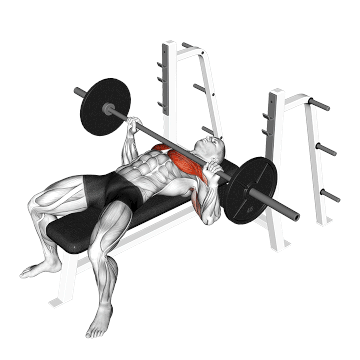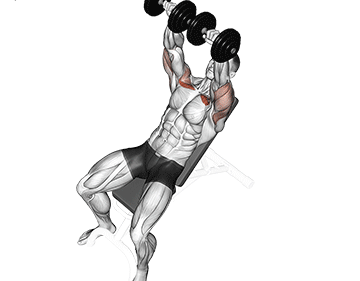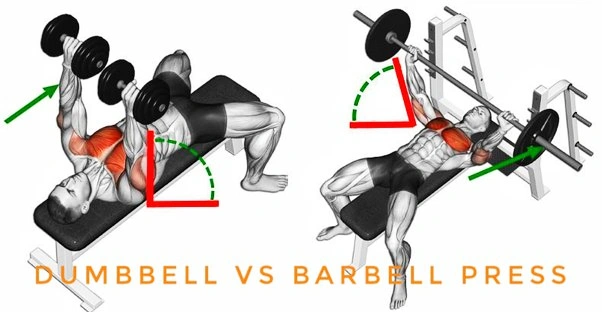Bench press bar vs dumbbells. Sounds fancy, but it’s really just barbell bench press vs dumbbell bench press.
Both work your chest, shoulders, and triceps.
The difference? How they feel when you lift.
With a barbell, it’s one big bar. Feels steady. Easy to stack more weight. Great if you want to push heavy. With dumbbells, each hand does its own thing. More freedom. Bigger range. Works those small stabilizer muscles too.
Ever walked into the gym, sat on the bench, and thought… “Bar? Or dumbbells?”
Let’s figure it out, so next time you know exactly what to grab.
Barbell Bench Press
Bench press bar, also called the classic barbell bench press, is one of the most popular lifts in the gym.
Simple setup. Big results. But if you’ve never done it before, that big steel bar can look… intimidating.

Muscles it hits
- Main target: chest (pectorals).
- Helpers: shoulders and triceps.
- Bonus: back and core for stability.
Step-by-step
- Lay back on the bench.
- Hands a little wider than your shoulders on the bar.
- Squeeze your shoulder blades together, chest up just a touch.
- Lower the bar to mid-chest — slow and controlled.
- Push it back up until arms are straight.
Dumbbell Bench Press
Dumbbell bench press is like the barbell version’s freer, more flexible cousin.
Instead of one big bar, you’ve got a weight in each hand.
This means more range of motion, more freedom in your movement, and more work for those small stabilizer muscles.

Muscles it hits
- Main target: chest (pectorals).
- Helpers: shoulders, triceps.
- Bonus: stabilizers in your arms, shoulders, and core.
Step-by-step
- Grab a dumbbell in each hand and sit on the bench, let them chill on your thighs.
- Lie back, then lift the dumbbells so they’re right over your chest.
- Palms facing forward, elbows bent at about 90°.
- Press the dumbbells up until arms are straight.
- Lower them slowly back to chest level.
Bench Press Bar vs Dumbbells
So, we’ve looked at the barbell bench press. We’ve talked about the dumbbell bench press.
Now it’s time to put them side by side.
Dumbbell vs Barbell bench press — same target muscles, but very different feel.
Here’s a quick side-by-side so you can see the differences at a glance:
| Feature / Aspect | Barbell Bench Press | Dumbbell Bench Press |
|---|---|---|
| Strength potential | Can lift heavier loads, ideal for max strength goals | Limited by how much you can handle in each hand |
| Range of motion | Shorter range, bar stops at chest | Greater range, allows deeper stretch |
| Stability | More stable, less work for stabilizer muscles | Less stable, works stabilizers harder |
| Joint friendliness | Can stress shoulders if form is off | Usually gentler on shoulders |
| Setup & safety | Easier to set up, but need a spotter for heavy lifts | Harder to get dumbbells into position when very heavy |
| Muscle balance | Slight imbalances can go unnoticed | Each arm works independently, exposes weak spots |
Quick take
With the barbell, you feel planted and powerful.
With dumbbells, it’s more about control and balance.
Some days you want raw weight.
Other days, you want that deep stretch and extra stability work.
Who Should Use Which
So, when it comes to bench press bar vs dumbbells, here’s how to choose without overthinking:
✅ Beginners
💡Start with dumbbells.
Lighter, easier to control, and they teach you to balance each arm.
If something feels wrong, just set them down — no scary moment like getting pinned under a bar.
✅ Strength-focused lifters
💡Go for the barbell bench press.
Stable, simple to load plates, and perfect for pushing serious weight.
Great for tracking progress and chasing that personal best.
✅ Muscle builders
💡Use both.
Barbell = heavy, low reps for raw power.
Dumbbells = moderate weight, higher reps, deeper stretch.
Combo hits your chest from every angle.
✅ Shoulder or joint concerns
💡Dumbbells are usually kinder on your joints.
You can rotate your wrists, adjust your angle, and keep things comfortable.
Ideal for rehab or long-term shoulder health.
In short:
Barbell = more weight, more stability.
Dumbbells = more range, more balance work.
Mix and match for your goals — no need to commit to just one.
Barbell and Dumbbell Bench Press Together
So, you’ve seen the strengths of each. You know who should use which.
But here’s the thing — you don’t actually have to pick one forever.
You can use barbell and dumbbell bench press in the same program — barbell for heavy power, dumbbells for control.
| Training Style | How to Do It | Why It Works 💡 |
|---|---|---|
| Weekly split | Day 1 → Barbell (heavy, low reps) | Hits both strength and endurance in the same week |
| Day 2 → Dumbbell (lighter, high reps) | ||
| Same-day combo | Start with barbell for heavy sets | Chest pump + stability training in one session |
| Switch to dumbbells for accessory work | ||
| Progressive load | Add weight to barbell weekly | Keeps you improving without wrecking your joints |
| Increase reps/ROM with dumbbells | ||
| Superset option | 1 set barbell → immediately 1 set dumbbells | Maximum pump, time-efficient |
In short:
Barbell = pure strength base.
Dumbbells = control, balance, and range.
Mix them smart, and your chest day will never be boring.
End of the day, bench press bar vs dumbbells is not about one winning and the other losing.
It’s about what works for you.
Barbell? Feels solid, easy to load weight, great for pure strength.
Dumbbells? More freedom, bigger stretch, and you’ll train those little stabilizer muscles too.
You don’t even have to pick just one.
Some days go heavy on the bar.
Other days grab the dumbbells for control and balance.
Mix them up, keep your training fresh.
So next time you walk into the gym, don’t stand there staring at both.
Just think about your goal, grab the right tool, and start pressing.
Simple as that.

Hi, I’m Alex Carter, part of the editorial team at Leadman Fitness. We specialize in crafting premium custom racks, cable machines, functional trainers, and strength accessories for home and commercial gyms. With a background in competitive powerlifting and gym design consulting, I’ve spent years testing gear under heavy loads and optimizing layouts for efficiency.
I focus on translating real-world user frustrations—like space limitations, budget constraints, or durability needs—into actionable solutions. By collaborating directly with our engineers and facility owners, I ensure our custom equipment evolves to solve the unspoken challenges lifters face daily. What I share isn’t textbook advice; it’s battle-tested insight from racks I’ve welded, cables I’ve replaced, and gym floors I’ve trained on.
